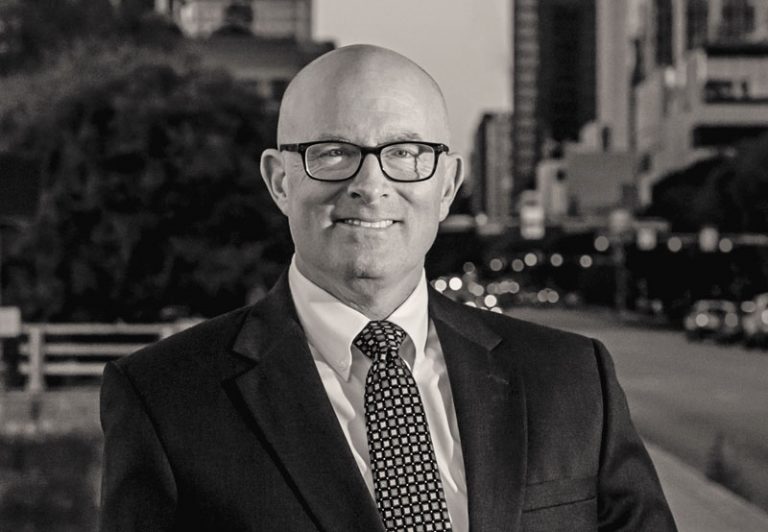Michael Baselice knows Ted Cruz. And Rick Perry. Arnold Schwarzenegger, too. He’s worked for many politicians and aspiring candidates including, as of this summer, the Trump for President campaign.
And he knows us. Very well.
He has been studying us voters on scatterplots, census tables and spreadsheets for 30 years, 19 of them as founder of Baselice & Associates, an Austin firm that conducts opinion polls for political campaigns, ballot initiatives and corporations. That experience gives him a clear-eyed view of how the opinion business not only measures, but also shapes, American politics. Which is to say, Baselice doesn’t just gauge how voters think, he also works hard to change their minds. Surveys are a way of testing what resonates with people, and Baselice uses that data — soaked in statistics techniques he acquired as an ’83 commerce and engineering alumnus of Drexel — to deduce what messages are most likely to influence the vote.
THE PLAYBOOK
Baselice runs his firm out of a suite of tidy offices in an office park in the Northwest Hills section of Austin, near Tarrytown, where he and his wife Julie raised their three children. Here on a desk flanked by a humorous print of past Republican presidents — whom he cheerfully greets each day — he plops down a thick three-ring binder and flips it open. Inside is a sample of his work: the results of a poll he ran in 2010 for Republican Texas Gov. Rick Perry, who was running for his third re-election, against U.S. Senator Kay Bailey Hutchison.
“Doesn’t this look like those things coaches carry on the sidelines of a football game?” he asks. “This was our playbook, this told us the best things to say about Rick Perry to different subgroups.”
The poll asked voters for whom they would vote in the upcoming election, then it posed various positive and negative statements about the two candidates. At the end, it repeated the initial ballot test question.
“And then we run multiple regression analysis — here comes that Drexel education! — to measure the correlation, or what we term the ‘persuasiveness’ of specific information, and see how the needle moved,” he explains.
In this case, the needle moved 13 percent of the respondents to Perry’s column.
The most persuasive messages — a tough stance on employers who hire illegal immigrants and a promise to make certain small business tax cuts permanent — were then used almost verbatim in a Perry campaign television spot that ran in the final weeks of the election.
Perry won re-election in a three-way race with 51 percent of vote.
“I don’t care what message helps my clients win,” Baselice says. “My job is to figure that out and make a recommendation.”
Such potent tactics are one way that Baselice evens the score between Republicans and Democrats, but not the only.
Baselice’s biggest contribution to the GOP has been behind the scenes, and dates back to the decade of Ronald Reagan and the years just before Newt Gingrich presided over the Republican Revolution of 1994 — when Republican candidates gained seats and control of state legislatures on a scale not previously seen in a generation.
CALCULATED CAMPAIGNS
Back then, Baselice was a new Drexel grad who’d come out to Texas to work for his co-op employer, Forney Engineering in North Dallas. He was moving up in the company, but in the early ’80s, Texas’ economy was out of gas and people with seniority were being laid off all around him. Self-employment started looking good.
So he got his real estate license. “And I quickly sold nothing,” he says.
“There was an 18-month supply of three-bedroom, two-bath, two-car garages,” he shrugs. “If you had money, you could have bought the town.”
He had so much free time not selling anything that he started teaching the math section of the real estate exam to others getting their licenses.
There, he met someone who worked for the Republican Party of Texas, which led to him being introduced to Carole Keeton Rylander, a former Austin mayor who was running for Congress.
It was 1986 and he was 25 with nothing to lose, so he volunteered to help with the race.
“We got only 28 percent of the vote,” he says. “But even though we were clobbered, I got bitten by campaigns and politics.”
Soon he was working for the Republican Party of Texas, helping to target state legislative districts likely to swing Republican.
As Baselice recalls, the political director of the state party was a Princeton grad, but despite his lofty credentials, he did not know how to apply straight linear regression to data on district voting strength. Baselice did.
“I simply did something that hadn’t been done before,” he says.
Baselice proved at the congressional and legislative district level that a mathematical correlation existed between how Republican or Democratic people in those districts had voted in previous contests.
The formula is called the ORVS, or Optimal Republican Voting Strength. It’s based on an old campaigning rule of thumb that says a good candidate running a good campaign should be able to get two-thirds of the difference between the base vote and the high vote in that district, averaged across two election cycles.
To this day, Baselice’s calculation is the gold standard used by just about everyone — candidates, political action committees and party leaders — to target vulnerable districts, says Allen Blakemore, a political consultant who uses Baselice’s polling services.
“This absolutely revolutionized the way we make targeting decisions in campaigns,” says Blakemore. “Before Mike, people did various things trying to achieve that calculation…some with a Ouija board. Mike applied the mathematical science to it.”
“This one organization I worked with spent almost $1 million based solely on Mike’s calculation, and I’m just one group of groups all over the country doing this using his calculations,” says Blakemore.
Republican Party of Texas leaders shared the method with their colleagues in 49 other states and asked Baselice to teach it to the party in Georgia, North Carolina and Kentucky. In the 1988 election, Republicans won 12 new state house seats in North Carolina and eight in Georgia.
TELL US HOW YOU REALLY FEEL.
 “You’d think everyone would do polls the same way…well, no two chefs make French toast the same way,” Base- lice says. “They all have eggs, but some may use Egg Beaters, some may not, some use vanilla, some may use cinnamon. Polling is like that. It really comes down to the sample design more so than the wording of the questions.”
“You’d think everyone would do polls the same way…well, no two chefs make French toast the same way,” Base- lice says. “They all have eggs, but some may use Egg Beaters, some may not, some use vanilla, some may use cinnamon. Polling is like that. It really comes down to the sample design more so than the wording of the questions.”
Oregon, a perennial blue state, adopted the calculation this year leading up to its primary.
“This was a step above anything we did before,” says Kevin Hoar, communications director of the Oregon Republican Party. “It’s the way he combines several different factors instead of just looking at straight Republican-Democratic differential.”
A LIKELY STORY
A similar calculation was employed at the national level, says Baselice. After his first doomed campaign in Texas, he spent a stint in Washington, D.C., working for the National Republican Congressional Committee, where in 1988 he was asked on behalf of Newt Gingrich to analyze how Reagan had performed versus Mondale in the 1984 presidential race in each of the country’s 435 Congressional districts.
Baselice found that Reagan carried over 80 percent of the Congressional districts. That detail was then used by Gingrich as the then-leader of GOPAC, a key Republican training organization, to rally candidates around the notion that America is a “center-right” country. And we know how well that worked out for Gingrich and the GOP.
The likelihood that the historic Republican Revolution of the ’80s and ’90s may have been owed in part to the widespread adoption of a calculation created by one Drexel grad is a question for the probability experts. But the math seems to add up.
As far as Baselice is concerned, it’s all part of the game.
“If you like politics and legislative issues and government, and you also like competition and sports, then nothing combines all of that together like campaigns for public office,” Baselice reflects. “The difference is, instead of a sporting event lasting a few hours, elections last a full year — and the polling lets us know the score periodically.”
WHY POLLS AREN’T WHAT THEY USED TO BE
By the time Election Day rolls around, polling firms and media outlets will have conducted scores of surveys of the American voter in an attempt to predict the winning candidate.
But you can’t trust every poll you see. Certain polling practices have become less reliable than they were just 10 years ago, Michael Baselice warns.
That’s because it’s become much harder to reach a truly representative sample. People screen their calls. They decline to participate. They increasingly use cell phones, which by law, have to be dialed manually and are therefore more costly to include in surveys.
Baselice says that when he got into the business in 1989, two people would agree to be surveyed for every one who declined. Now, only one in a dozen agrees to be surveyed.
To get around this sampling problem, pollsters artificially inflate their sample by “weighting” participants to reflect typical demographics of the electorate. That’s where things get interesting.
“You’d think pollsters would weight survey data the same way. Well, no two chefs make French toast the same way,” he says. “They all have eggs, but some may use Egg Beaters, some may not, some use vanilla, some may use cinnamon. Polling is like that. It really comes down to the sample design more so than the wording of the question.”
To illustrate, Baselice pulls up an actual poll from RealClearPolitics.com’s collection of national election poll results, and he starts poking into its methodology.
It says it’s a poll of 1,000 adults, but nowhere does it say it’s a poll of confirmed registered voters, he notes.
“It’s much cheaper for a news organization to do a survey of adults, then break out registered voters from that, and then break out Republican and Democratic voters from that, and call the latter breakout a sample of primary voters,” he says. “But they’re not necessarily primary voters; they’re adults who call themselves Democrats or Republicans. When I do a survey of Republican primary voters, I use a list of people who have past primary vote history. That gets you a truer read of how the candidates and their campaigns are doing.”
To be a faithful reflection of the country, look for polls to have at least 35 percent of the calls made to cell phones, says Baselice. They should have slightly more women than men. They should be weighted not only to reflect national demographics, but also regional differences.
“Don’t you think the Northeast and the West Coast voters are more Democratic than Republican and don’t you think Georgia over to Texas on up to North Dakota votes more Republican than Democratic?” he asks.
“When you dig down into the methodology between two surveys, there you will see how you may be comparing red apples to green apples or even pears to apples,” Baselice says.



